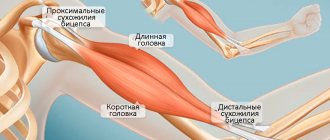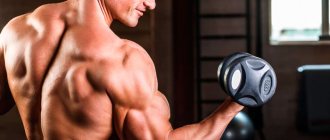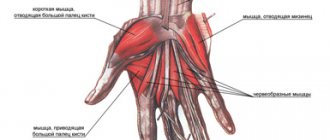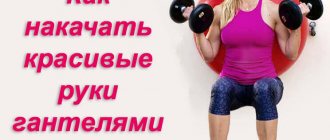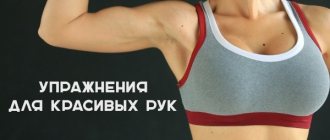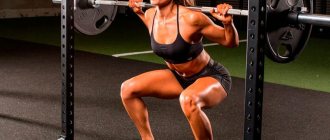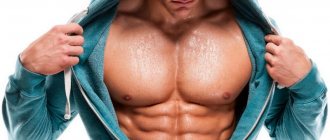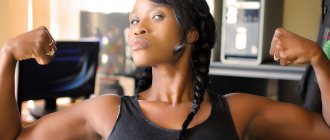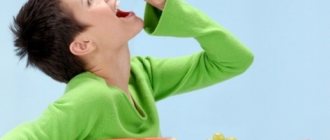Why is it important to develop your forearms? In this article, you will learn what role these muscles play, and also get acquainted with exercises that stimulate their growth, regardless of genetic characteristics.
Massive forearms are considered a sign and calling card of a real bodybuilder or athlete. Indeed, developed, muscular forearms create a feeling of gigantic strength. And from a functional point of view, they allow the athlete to work with ever-increasing weights.
The forearms increase grip strength and are thus involved in pulling exercises. On stage, underdeveloped forearms immediately catch the eye and also disrupt the proportions of the body.
If you want bigger muscles, you will have to do specific exercises and training for your forearms. In addition to being one of the most difficult muscles to grow, their shape and size limit are determined by genetics. And those whom nature has not endowed with good heredity will have to work hard during training.
Anatomy of arm muscles
The arm muscles have many large, visible muscles that help us with everyday activities, such as changing clothes or lifting weights.
The complex design of the forearms allows us to perform completely different movements of our hands. Our fingers are also amazingly designed to allow us to grip barbells and dumbbells. All parts of the forearm, hand, fingers interact so harmoniously with each other that it is a real ensemble of bones, ligaments and tendons.
34 complex muscles provide varied mobility of our fingers and hands. They are so strong that trained people can support their weight by grasping something with a few fingertips.
| Brachioradialis (brachioradialis muscle) | It is located on the front of the forearm. It starts from the shoulder, or rather from the outer part of it, after which it makes an intersection through the elbow and extends to the radius. Involved in elbow flexion and also helps rotate the forearm up/down. |
| Wrist support | It is thanks to this muscle that we can supinate while pumping the biceps, since it rotates the hand outward. Resembles a thin plate in the shape of a triangle. It is attached from our elbow to the thumb side. |
| Extensor carpi radialis longus | Be located next to the brachioradialis on the side of the triceps muscle. Participates in the outward extension of our hand. |
| Flexor carpi radialis and ulnaris | These muscles are visible on the biceps side on the inside of our forearms. They work when you need to bend your hands towards yourself. They also perform pronation of the hand (turn it outward), this is their additional function. |
| Extensors and flexors of the fingers | These muscles are located throughout the forearm, on its outer and inner sides. They provide grip strength, but add little volume. |
| Pronator teres | The main function of this muscle is to turn the hand inward from the side of our little finger. Also involved in forearm flexion. |
| Pronator quadratus | Similar to the round one, but differs in that it has the shape of a plate with four corners and is located next to the palm. |
Just as with the calf muscles, the forearms require frequent and heavy loads. Despite the fact that when working with heavy weights (especially with various rows without wrist belts), the forearms are also involved, it is still better to do special exercises.
Anatomy
The forearm is the part of the arms from the elbow to the hand. The muscle group consists of:
- brachial muscle - brachialis;
- flexors;
- pronator teres;
- brachioradialis muscle – brachioradialis;
- extensors.
These muscles are classified as “small” and are responsible for rotation, flexion/extension of the arms at the wrist and elbow joints. The complex anatomical structure further complicates the task of pumping up the forearm. During the exercise, all the muscles of this anatomical group, of which there are only five, should be involved.
Why pump up your forearms?
Statistics show that one of the first things girls pay attention to in a man when meeting or getting to know him is his hands, and this is not surprising.
Reason #1. Aesthetic
Let's speak frankly. Most bodybuilders develop their forearms to make them look bigger and ultimately balance out their physique.
Massive forearms create the impression of enormous strength, that is, they reflect the physical capabilities of a person. In addition, the forearms, as well as the neck, are often the only visible parts of the body. But when athletes start doing wrist curls, few of them think about effectiveness and safety.
Reason #2. Safety and grip strength
Strong forearms allow you to perform various exercises on other muscle groups. Often the forearms can be a bit of a weak link, limiting your exercise options.
For example, to properly work your back, you need reverse-grip pull-ups and bent-over barbell rows, in which strong forearms play a leading role.
Reverse grip pull-ups
Grasp the horizontal bar with a reverse grip, at a distance slightly narrower than shoulder width. Keep your body straight. As you exhale, pull your body up, keeping your elbows closer to your body. Only the arms move. As you inhale, slowly return to the starting position.
Reverse grip pull-ups
Strong forearms require development of the entire upper body, and the athlete can lift more weight without risk of injury. Thus, forearm exercises are the key to safe and more effective training.
Bent-over barbell row
Take the barbell with an overhand grip, bend your knees slightly and tilt your body forward no more than 30 degrees. As you exhale, pull the barbell towards you. At the top point, tighten your back muscles and hold. As you inhale, slowly lower the barbell back down.
Bent-over barbell row
As with the calf muscles, the forearms require frequent and heavy loads. Although the forearms are involved when lifting heavy weights (especially during various deadlifts without wrist straps), it is better to perform specific exercises for the forearms.
Why is such training necessary?
In terms of appearance, developed forearms play an important role, providing the impression of massiveness, power, and physical strength. Also visually the body looks symmetrical (naturally, if other muscle groups are pumped up).
We should not forget about the impression on others that bodybuilders make in clothes, since in most cases it is the forearms and neck that are exposed. And this can be called a compelling argument, since a person with an ideal body in any society feels more confident and comfortable than others.
According to experts, regular training of this muscle group is also necessary from a safety point of view, since it minimizes the risk of injury during complex complexes. This applies, for example, to an exercise for the back such as pull-ups with additional weight, where you need a good grip, the strength and strength of which depends on the muscles of the forearm. This is a difficult exercise and, like any other with heavy weight, can only be performed with strong arms.
The best forearm exercises in the gym
The forearms are a fairly complex group of small muscles with several functions.
- The brachialis and brachioradialis muscles help flex the arm at the elbow and assist the forearm during flexion.
- The pronator teres muscle helps the forearm in the prone position, as well as when bending the arm at the elbow joint.
- The flexor muscles palmaris longus, flexor carpi radialis, and flexor carpi ulnaris flex the palm, while the extensor ulnaris and extensor carpi radialis brevis muscles extend the palm.
And each of these muscles must be loaded to one degree or another with special exercises.
Extensor exercises
These muscles consist of eight heads: extensor digitorum, extensor carpi radialis longus, extensor carpi radialis brevis, extensor carpi ulnaris, extensor index finger, extensor carpi radialis longus, extensor pollicis longus and extensor pollicis brevis.
These muscles extend beyond the forearm, so it is very important to develop them with the following exercises:
Barbell Palms Down Wrist Curl
Sit so that your forearms rest on your hips and your hands and the barbell are suspended. Palms are turned down. As you exhale, raise your wrists. As you inhale, lower it. The forearms do not move.
Barbell Palms Down Wrist Curl
Reverse grip biceps curl
Stand in front of the pulley, grab the handle and straighten up. As you exhale, keeping your shoulders still, pull the handle up to shoulder level, keeping your elbows close to your sides. As you inhale, return to the starting position.
Reverse grip biceps curl
Standing Pronated Grip Dumbbell Raise
Stand up straight and hold dumbbells with a pronated grip (palms facing down). The arms are extended along the body. As you exhale, contracting your biceps, lift the dumbbells to shoulder level. At the top point, pause for a second. Make sure you only work your forearms.
Standing Pronated Grip Dumbbell Raise
To vary the work and stimulate further growth of the extensor muscles, perform one of these exercises each workout with a palms-down grip on the bar. Your forearms should rest completely on your knees. Lower the weight so that the muscles are greatly stretched. Then extend your wrists for maximum contraction. If you're using dumbbells, work with each arm in turn.
Extensor exercises
This is the largest muscle of the forearm, stretching along the entire length of its inner part. The flexors consist of six heads: flexor digitorum superficialis, flexor digitorum profundus, flexor carpi radialis, flexor carpi ulnaris, palmaris longus and flexor pollicis longus.
The best exercises for the forearm flexor muscles:
Wrist curl with a barbell while sitting on a bench, palms up
Sit so that your forearms rest on your hips and your hands and the barbell are suspended. Palms are turned up. As you exhale, raise your wrists. As you inhale, lower it. The forearms do not move.
Wrist curl with a barbell while sitting on a bench, palms up
Bend the wrists on the lower block while sitting on a bench
Sit on a bench and grab the handle of the lower block. Palms face up. As you inhale, lower the handle as low as possible. As you exhale, raise the handle as much as possible, tensing the muscles of your forearms.
Bend the wrists on the lower block while sitting on a bench
Wrist curl while sitting on a bench with dumbbells, palms up
Sit so that your forearms rest on your thighs and your hands and dumbbells are suspended. Palms face up. As you exhale, raise your wrists. As you inhale, lower it. The forearms do not move.
Wrist curl while sitting on a bench with dumbbells, palms up
To perform this movement, hold the bar as you would for a normal barbell lift. Place your forearms on your thighs and bend your wrists upward as hard as possible. Tighten your muscles and return to the starting position.
Exercises on the brachioradialis muscle
The brachioradialis muscle is located on the outside of the forearm and is a thick, rope-like muscle that can be easily seen when the arm is fully extended. It consists of only one head - the brachioradialis.
Recommended exercises for the brachioradialis muscle:
Reverse grip barbell lift
Stand up straight with a barbell in your hands. Place your elbows close to your body. Keeping your shoulders motionless, as you exhale, lift the barbell to shoulder level, tightening your biceps. As you inhale, slowly lower to the starting position.
Reverse grip barbell lift
Biceps curls on a Scott bench with an EZ barbell with a reverse grip
Grab the bar with a medium overhand grip. Place your triceps on the pad of the bench and, straightening your arms, lower the barbell. As you exhale, contracting your biceps, bend your arms to shoulder level. As you inhale, slowly return to the starting position.
Biceps curls on a Scott bench with an EZ barbell with a reverse grip
Reverse grip biceps curl
Stand in front of the pulley, grab the handle and straighten up. As you exhale, keeping your shoulders still, pull the handle up to shoulder level, keeping your elbows close to your sides. As you inhale, return to the starting position.
Reverse grip biceps curl
Alternating dumbbell curls while standing
Take dumbbells and stand straight. Keeping your shoulders still, raise one arm and rotate your wrist at the same time. Contract your biceps fully and bring the dumbbell to your shoulder. Return to the starting position. Switch hands and repeat.
Alternating dumbbell curls while standing
Ultimately, you yourself will find your ideal exercises by trying all of the above. We are completely sure of one thing, they definitely work.
Work with dumbbells
"Zottman Curls"
It is a mandatory component of a training complex with dumbbells for this muscle group. This is one of the options for working with a barbell on the forearms, only dumbbells are used instead of this apparatus. The latter are held in the lower position (like a hammer); during the upward movement, the forearm is pronated (turning the palms down). Then the projectiles are lowered in the reverse order of movements.
Seated Wrist Curl
Another exercise - bending the arms in a sitting position - is performed like a similar training with a barbell, but with dumbbells. Also, training each arm in turn in a sitting position with dumbbells will be effective.
Ways to enlarge your forearm at home
Forget about wrist straps
Wrist straps relieve the load on the forearms and compensate for a weak grip, but in this case the muscles of the forearms are weakly loaded. To properly work out the forearms, maximum muscle contraction is necessary, which is impossible with belts.
Buy collapsible dumbbells
With this amazing equipment, you will have a lot of opportunities to quickly pump up your arm muscles at home, diversify the number of available movements with new exercises and complexes with dumbbells for the arms.
Use a thick bar
This will make your grip more difficult, and as a result of regular training, the size of your forearm will increase. If you don't have a thick bar at hand, simply wrap a towel around a regular bar. Similar equipment can be thought of at home.
Useful video from Yuri Spasokukotsky on developing grip and forearm strength using the Axel Apollo deadlift.
Wind the rope onto a weighted roller
Stand up straight and grab the roller with your palms facing down. Raise your arms parallel to the floor. Start winding the rope onto the roller by turning each hand up and down in turn. When the weight reaches the roller, slowly unwind the rope using the same wrist movements.
Winding rope onto a wrist roller
Essentially, this device is a heavy plate attached to a small handle with a thin rope.
- Slowly raise the handle with straight arms to shoulder level and begin to wind the rope onto the roller by turning your hands.
- When the weight reaches the roller, slowly unwind the rope with reverse movements of your wrists. Then relax and repeat the exercise.
Box
Hitting the punching bag repeatedly will also help develop forearm strength. Incorporate these exercises into your program from time to time and you will soon see progress. For example, 50 uppercuts with each hand perfectly develop the forearm flexors.
Use isometric exercises
Sets of isometric exercises for the forearms allow you to strengthen the muscle frame, increase strength and improve athletic performance without grueling hours of training in the gym.
Its effectiveness and accessibility to everyone has been proven over time, as well as its widespread use in yoga, bodybuilding, fitness, rehabilitation programs, martial arts and strength training.
How to pump up your forearms and why do it?
The main problem is that many athletes simply do not understand why they need to pump their forearms. The reason for this was some professional programs in which top athletes work this muscle group very moderately. This allows you to visually highlight the biceps and increase its volume. By the same principle, many pros rarely shake their necks; this makes it possible to visually widen the shoulders. However, in other strength sports, the forearms are rated as the most important muscle group that influences overall fitness and strength. Why do you need to include 1-2 workouts per week for this muscle group? Among the main reasons:
- Increased grip strength and improved progression in all basic movements that involve the arms (pull-ups, deadlifts, etc.);
- Improving the overall aesthetics of the arms - with powerful forearms, the arm muscles will look more massive;
- Increased functionality.
It is also important to devote sufficient time to training the lower arms for athletes who engage in any kind of martial arts. This muscle group will directly influence not only the force of the blow, but also reduce the risk of injury.
In general, if we take statistics as an example, it is weak forearms that prevent novice athletes from fully performing pull-ups and rows with heavy weights. The bottom line is that one muscle group significantly slows progression in the major movements of most upper body workouts. Fortunately, with proper attention and effective exercises, you can easily catch up: increase strength and muscle mass, and strengthen your grip.
Forearm training - A
Wrist curl with a barbell while sitting on a bench, palms up
- 3 sets of 12-15 reps
- Body part: Forearms and wrists Equipment: Barbell
Reverse grip biceps curl
- 3 sets of 12-15 reps
- Body Part: Biceps Equipment: Block
Alternating dumbbell curls while standing with a Hammer grip
- 3 sets of 12-15 reps
- Body part: Biceps Equipment: Dumbbells
Bend the wrists on the lower block while sitting on a bench
- 2 sets of 12-15 reps, forward and reverse grip
- Body Part: Forearms and Wrists Equipment: Block
Add to Calendar * Add to My Workouts * Print Workout
* — The service is in beta testing
As for the timing of working on the forearms, that is a completely different story: it is better to train them once a week, preferably at the end of the biceps workout.
Reverse Grip Curl
Add a weight to the bar that is comfortable to work with during the exercise. Stand with your back straight. Then bend your arms up halfway and hold the barbell for a couple of seconds. Then slowly lower back to the starting position.
Next, holding the barbell, bend your arms to the middle and twist them all the way up. When performing this exercise, the bottom point of each repetition will be the middle link of the entire movement. 3 sets of at least 8 repetitions will give good results.
Forearm training - B
Standing Pronated Grip Dumbbell Raise
- 3 sets of 12-15 reps
- Body part: Biceps Equipment: Dumbbells
Wrist curl while sitting on a bench with dumbbells, palms up
- 3 sets of 12-15 reps
- Body part: Forearms and wrists Equipment: Dumbbells
Standing biceps curl with reverse grip
- 3 sets of 12-15 reps
- Body part: Biceps Equipment: Barbell
Add to Calendar * Add to My Workouts * Print Workout
* — The service is in beta testing
You can also work on the muscles of the forearms on separate days, for example, 2 times a week, or combine them with calf training.
Home workout for forearms
There are several fairly simple but important recommendations that you need to know about before starting classes:
- When pumping up the forearms, many of the same muscles are used as when working on the biceps. And if you focus on one group, the result of this approach will be overtraining. Therefore, both biceps and forearm should be trained on different days, and not on the same day.
- To work out your forearms when you plan to exercise at home, you need to have a dumbbell at your disposal, but it would be better to also have a barbell with weights.
- To load the forearms, it should be noted that this muscle group is small. Therefore, in each approach it is necessary to do many repetitions, that is, from 15 to 20.
- It is necessary to train the forearms not before the biceps, but after.
The correct approach to building training is also important. It is better to do basic exercises first, and only then isolation exercises.
Forearm workout - B
Barbell Palms Down Wrist Curl
- 3 sets of 12-15 reps
- Body part: Forearms and wrists Equipment: Barbell
Bend the wrists on the lower block while sitting on a bench
- 3 sets of 12-15 reps
- Body Part: Forearms and Wrists Equipment: Block
Reverse grip biceps curl
- 3 sets of 12-15 reps
- Body Part: Biceps Equipment: Block
Add to Calendar * Add to My Workouts * Print Workout
* — The service is in beta testing
One-arm wrist curls
Choose a dumbbell of the appropriate size and weight. Sit on a bench and hold a dumbbell so that your elbow and forearm rest on your thigh and your hand hangs loosely from your knee.
The elbow should be bent at an angle of 90 degrees, and the palm should be raised up. Now lower your hand with the dumbbell down and bend your wrist up so that your palm is facing your shoulder. Try to do it slowly. Perform 3 sets of at least 10 repetitions.
A little anatomy
As you can see, the forearm is made up of dozens of small muscles. Only the main ones are labeled in the picture. All the muscles that move the hand and fingers in one way or another are located in this area. Each hand has 5 fingers. Each finger moves approximately the same number of muscles. Plus also the muscles that move the hand. So it turns out - several dozen thin muscles in one area.
That is, to pump up your forearm you need to train not only your hands, but also your fingers. I think this is clear. Now let's look at each exercise in detail. And let's start with the fingers.
"Stubborn" muscles
Since the forearms work when performing exercises on other muscle groups and are involved in everyday life, their resistance to stress is quite high. Therefore, these muscles are called “stubborn”, and their development is a very labor-intensive process that requires patience and perseverance.
First, let's decide how many times a week you can pump your forearms. For the harmonious development of this muscle group, you need to perform exercises twice a week. In this case, each exercise should be done in 3 sets of 10-15 repetitions each. An important nuance is that before training your forearms, you should perform a full warm-up and warm-up: these muscles are quite often injured. You should also not allow excessive muscle stretching at the end points of the range of motion.
It is best to train your forearms in conjunction with training your arms and back. But exercises for the forearms should be done at the end of classes, when the muscles of the back and arms have already been worked out, otherwise there will be no full return from the training.
It is not recommended to train your forearms more than twice a week. These muscles require a minimum of 48 hours, preferably 72, to recover. If you regularly overexert your forearms, chronic pain in the wrist area may occur.
Forearm strength and mass
Strong forearms are needed in certain types of martial arts, wrestling, and arm wrestling.
For those who are strengthening their grip, iron forearms are a must. In the latter case, the muscles are trained very actively, especially the inner part of the elbow.
Those who engage in arm wrestling also need to pump up this muscle group. These people fight on their hands, it is not so much the grip that decides, but the strength of the forearms, triceps and biceps.
Strong forearms, like all other muscles, are also needed by lifters who lift weights. In their body, every muscle that can be pumped up must be as strong as possible.
Among bodybuilders, the question of how to pump up your forearms is not heard so often. And there are two reasons. Half of the athletes do not know that these muscles can be specially pumped. And the other half believes that, for example, the brachioradialis muscle swings enough during exercises for other muscles. This is the one that is located on the outside of the forearm and allows you to bend the hand with the back side up.
Those who believe that you can pump up your forearm muscles without acupressure exercises are partly right. After all, all the exercises in which you pick up a dumbbell, a barbell, even a horizontal bar, involve your forearms, mainly their inner part.
To engage the back of these muscles, you need to do, for example, a biceps curl with an overhand grip. Great exercise - because you get more than just a toned bicep flexor!
In general, any biceps exercise works well for the forearms. This is true and if this is enough for you, you can stop there.
If you want to target these muscles, in particular, learn how to pump up the brachioradialis muscle, read on. We will give several exercises for the muscles of the forearm.
Why train your forearms?
They actively participate in movements where they need to hold something. In biceps curls, vertical, horizontal and rows from the floor, barbell and dumbbell presses. Therefore, they often do not need additional training.
But we are all different. For some, this group develops indirectly, while others suffer with underdeveloped hands. This problem reduces the quality of training. The athlete cannot hold the apparatus, even if he is able to perform 1-2 more failure repetitions.
At the first stages of training, it is recommended to abandon wrist straps. They take the load off the forearms, preventing them from developing.
If during training, equipment keeps slipping out of your hands, pay extra attention to your forearms. Also, if you plan to take up arm wrestling, be sure to include training for your hands and forearms
in your split.

